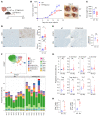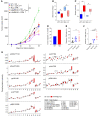Systemic inhibition of PTPN22 augments anticancer immunity
- PMID: 34283806
- PMCID: PMC8409589
- DOI: 10.1172/JCI146950
Systemic inhibition of PTPN22 augments anticancer immunity
Abstract
Both epidemiologic and cellular studies in the context of autoimmune diseases have established that protein tyrosine phosphatase non-receptor type 22 (PTPN22) is a key regulator of T cell receptor (TCR) signaling. However, its mechanism of action in tumors and its translatability as a target for cancer immunotherapy have not been established. Here we show that a germline variant of PTPN22, rs2476601, portended a lower likelihood of cancer in patients. PTPN22 expression was also associated with markers of immune regulation in multiple cancer types. In mice, lack of PTPN22 augmented antitumor activity with greater infiltration and activation of macrophages, natural killer (NK) cells, and T cells. Notably, we generated a novel small molecule inhibitor of PTPN22, named L-1, that phenocopied the antitumor effects seen in genotypic PTPN22 knockout. PTPN22 inhibition promoted activation of CD8+ T cells and macrophage subpopulations toward MHC-II expressing M1-like phenotypes, both of which were necessary for successful antitumor efficacy. Increased PD1-PDL1 axis in the setting of PTPN22 inhibition could be further leveraged with PD1 inhibition to augment antitumor effects. Similarly, cancer patients with the rs2476601 variant responded significantly better to checkpoint inhibitor immunotherapy. Our findings suggest that PTPN22 is a druggable systemic target for cancer immunotherapy.
Keywords: Cancer immunotherapy; Drug therapy; Immunology; Oncology.
Conflict of interest statement
Figures






References
Grants and funding
- P50 CA221707/CA/NCI NIH HHS/United States
- P50 CA062924/CA/NCI NIH HHS/United States
- S10 RR025141/RR/NCRR NIH HHS/United States
- P50 CA098131/CA/NCI NIH HHS/United States
- P30 CA068485/CA/NCI NIH HHS/United States
- R01 CA214494/CA/NCI NIH HHS/United States
- R01 CA207288/CA/NCI NIH HHS/United States
- UL1 RR024975/RR/NCRR NIH HHS/United States
- UL1 TR002243/TR/NCATS NIH HHS/United States
- R01 CA197296/CA/NCI NIH HHS/United States
- R01 CA194024/CA/NCI NIH HHS/United States
- UL1 TR000445/TR/NCATS NIH HHS/United States
- T32 CA009071/CA/NCI NIH HHS/United States
- R50 CA243627/CA/NCI NIH HHS/United States
- R01 LM010685/LM/NLM NIH HHS/United States
- P01 CA247886/CA/NCI NIH HHS/United States
LinkOut - more resources
Full Text Sources
Molecular Biology Databases
Research Materials

